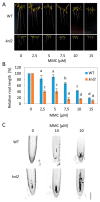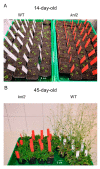Depletion of KNL2 Results in Altered Expression of Genes Involved in Regulation of the Cell Cycle, Transcription, and Development in Arabidopsis
- PMID: 31731608
- PMCID: PMC6888302
- DOI: 10.3390/ijms20225726
Depletion of KNL2 Results in Altered Expression of Genes Involved in Regulation of the Cell Cycle, Transcription, and Development in Arabidopsis
Abstract
Centromeres contain specialized nucleosomes at which histone H3 is partially replaced by the centromeric histone H3 variant cenH3 that is required for the assembly, maintenance, and proper function of kinetochores during mitotic and meiotic divisions. Previously, we identified a KINETOCHORE NULL 2 (KNL2) of Arabidopsis thaliana that is involved in the licensing of centromeres for the cenH3 recruitment. We also demonstrated that a knockout mutant for KNL2 shows mitotic and meiotic defects, slower development, reduced growth rate, and fertility. To analyze an effect of KNL2 mutation on global gene transcription of Arabidopsis, we performed RNA-sequencing experiments using seedling and flower bud tissues of knl2 and wild-type plants. The transcriptome data analysis revealed a high number of differentially expressed genes (DEGs) in knl2 plants. The set was enriched in genes involved in the regulation of the cell cycle, transcription, development, and DNA damage repair. In addition to comprehensive information regarding the effects of KNL2 mutation on the global gene expression, physiological changes in plants are also presented, which provides an integrated understanding of the critical role played by KNL2 in plant growth and development.
Keywords: Arabidopsis; KNL2; RNA-seq; centromere; kinetochores.
Conflict of interest statement
The authors declare no conflict of interest.
Figures







Similar articles
-
Arabidopsis kinetochore null2 is an upstream component for centromeric histone H3 variant cenH3 deposition at centromeres.Plant Cell. 2013 Sep;25(9):3389-404. doi: 10.1105/tpc.113.114736. Epub 2013 Sep 6. Plant Cell. 2013. PMID: 24014547 Free PMC article.
-
Targeting of Arabidopsis KNL2 to Centromeres Depends on the Conserved CENPC-k Motif in Its C Terminus.Plant Cell. 2017 Jan;29(1):144-155. doi: 10.1105/tpc.16.00720. Epub 2017 Jan 6. Plant Cell. 2017. PMID: 28062749 Free PMC article.
-
Knockdown of CENH3 in Arabidopsis reduces mitotic divisions and causes sterility by disturbed meiotic chromosome segregation.Plant J. 2011 Oct;68(1):40-50. doi: 10.1111/j.1365-313X.2011.04664.x. Epub 2011 Jul 21. Plant J. 2011. PMID: 21635586
-
Centromeric chromatin and its dynamics in plants.Plant J. 2015 Jul;83(1):4-17. doi: 10.1111/tpj.12875. Plant J. 2015. PMID: 25976696 Review.
-
Transcribing Centromeres: Noncoding RNAs and Kinetochore Assembly.Trends Genet. 2018 Aug;34(8):587-599. doi: 10.1016/j.tig.2018.05.001. Epub 2018 Jun 2. Trends Genet. 2018. PMID: 29871772 Review.
Cited by
-
Plant kinetochore complex: composition, function, and regulation.Front Plant Sci. 2024 Oct 10;15:1467236. doi: 10.3389/fpls.2024.1467236. eCollection 2024. Front Plant Sci. 2024. PMID: 39464281 Free PMC article. Review.
-
High temperature increases centromere-mediated genome elimination frequency and enhances haploid induction in Arabidopsis.Plant Commun. 2023 May 8;4(3):100507. doi: 10.1016/j.xplc.2022.100507. Epub 2022 Dec 20. Plant Commun. 2023. PMID: 36540022 Free PMC article.
-
Exploring potential strategies for haploid induction based on double fertilization in plants.Plant Biotechnol J. 2025 Sep;23(9):4000-4016. doi: 10.1111/pbi.70197. Epub 2025 Jun 18. Plant Biotechnol J. 2025. PMID: 40534170 Free PMC article. Review.
-
Chromatin, Epigenetics and Plant Physiology.Int J Mol Sci. 2020 Apr 16;21(8):2763. doi: 10.3390/ijms21082763. Int J Mol Sci. 2020. PMID: 32316114 Free PMC article.
-
Maize centromeric chromatin scales with changes in genome size.Genetics. 2021 Apr 15;217(4):iyab020. doi: 10.1093/genetics/iyab020. Genetics. 2021. PMID: 33857306 Free PMC article.
References
MeSH terms
Substances
Grants and funding
LinkOut - more resources
Full Text Sources
Molecular Biology Databases

